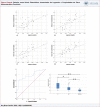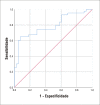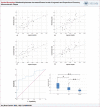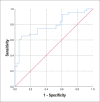Relationship between Increased Plasma Levels of Legumain and Properties of Coronary Atherosclerotic Plaque
- PMID: 37909538
- PMCID: PMC10593388
- DOI: 10.36660/abc.20230395
Relationship between Increased Plasma Levels of Legumain and Properties of Coronary Atherosclerotic Plaque
Abstract
Background: Many clinical studies have confirmed that legumain is closely related to atherosclerosis. Unfortunately, different conclusions have been reached, and analyses and studies on atherosclerotic plaque characteristics in patients with increased plasma levels of legumain are still lacking.
Objectives: This study aimed to investigate the correlation between legumain and coronary atherosclerotic plaque characteristics.
Methods: A total of 81 patients with coronary atherosclerotic heart disease (CHD), including 43 patients with unstable angina (UA) and 38 patients with stable angina (SA), were screened by coronary angiography. Intravascular ultrasound (IVUS) was performed to evaluate the characteristics of coronary atherosclerotic plaques, and plasma legumain levels were also measured. Values of p < 0.05 were considered significant.
Results: Legumain concentration was significantly higher in the two CHD subgroups than in the control group (all p<0.001). Legumain concentrations in the UA group were significantly higher than in the SA group (p=0.001). The plaque area, remodeling index (RI), and eccentricity index (EI) in the UA group were significantly higher than those in the SA group (p<0.001, p=0.001, p=0.001, respectively). There was a significant positive correlation between legumain levels and RI and EI in both UA and SA patients (all p<0.05).
Conclusions: High plasma levels of legumain were closely related to the occurrence and severity of CHD, and the lesions tended to be unstable. Legumain is expected to be a potential inflammatory biomarker for the diagnosis of CHD and the early identification of unstable coronary lesions.
Fundamento: Muitos estudos clínicos confirmaram que a legumain está intimamente relacionada à aterosclerose. Infelizmente, chegaram-se a conclusões diferentes e ainda faltam análises e estudos sobre as características da placa aterosclerótica em pacientes com níveis plasmáticos aumentados de legumain.
Objetivos: Este estudo teve como objetivo investigar a correlação entre as características da legumain e da placa aterosclerótica coronariana.
Métodos: Um total de 81 pacientes com doença cardíaca aterosclerótica coronariana (DCAC), incluindo 43 pacientes com angina instável (AI) e 38 pacientes com angina estável (AE), foram examinados por angiografia coronária. Foi realizado ultrassom intravascular (IVUS) para avaliar as características das placas ateroscleróticas coronarianas, e os níveis plasmáticos de legumain também foram medidos. Valores de p < 0,05 foram considerados significativos.
Resultados: A concentração de legumain foi significativamente maior nos dois subgrupos de doença coronariana do que no grupo controle (todos p<0,001). As concentrações de legumain no grupo AI foram significativamente maiores do que no grupo SA (p=0,001). A área de placa, o índice de remodelamento (IR) e o índice de excentricidade (IE) no grupo AI foram significativamente maiores do que no grupo AE (p<0,001, p=0,001, p=0,001, respectivamente). Houve uma correlação positiva significativa entre os níveis de legumain e IR e IE em pacientes com AI e AE (todos p<0,05).
Conclusões: Níveis plasmáticos elevados de legumain estavam intimamente relacionados com a ocorrência e gravidade da doença coronariana, e as lesões tendiam a ser instáveis. Espera-se que a legumain seja um potencial biomarcador inflamatório para o diagnóstico de doença coronariana e a identificação precoce de lesões coronárias instáveis.
Conflict of interest statement
Potencial conflito de interesse
Não há conflito com o presente artigo
Figures








Similar articles
-
Association of lipoprotein-associated phospholipase A₂ with characteristics of vulnerable coronary atherosclerotic plaques.Yonsei Med J. 2011 Nov;52(6):914-22. doi: 10.3349/ymj.2011.52.6.914. Yonsei Med J. 2011. PMID: 22028154 Free PMC article.
-
Relationship between plasma cathepsin S and cystatin C levels and coronary plaque morphology of mild to moderate lesions: an in vivo study using intravascular ultrasound.Chin Med J (Engl). 2009 Dec 5;122(23):2820-6. Chin Med J (Engl). 2009. PMID: 20092784
-
High Plasma Levels of Legumain in Patients with Complex Coronary Lesions.J Atheroscler Thromb. 2020 Jul 1;27(7):711-717. doi: 10.5551/jat.52027. Epub 2019 Nov 18. J Atheroscler Thromb. 2020. PMID: 31735728 Free PMC article.
-
Prevalence and predictors of culprit plaque rupture at OCT in patients with coronary artery disease: a meta-analysis.Eur Heart J Cardiovasc Imaging. 2016 Oct;17(10):1128-37. doi: 10.1093/ehjci/jev283. Epub 2015 Oct 27. Eur Heart J Cardiovasc Imaging. 2016. PMID: 26508517 Review.
-
Intravascular ultrasound insights into the unstable features of the coronary atherosclerotic plaques: A systematic review and meta-analysis.Eur J Clin Invest. 2022 Jan;52(1):e13671. doi: 10.1111/eci.13671. Epub 2021 Aug 30. Eur J Clin Invest. 2022. PMID: 34411283
Cited by
-
Legumain - Another Piece in the Complex Puzzle of Atherosclerotic Plaque Formation and Vulnerability.Arq Bras Cardiol. 2023 Nov;120(11):e20230743. doi: 10.36660/abc.20230743. Arq Bras Cardiol. 2023. PMID: 38126488 Free PMC article. English, Portuguese. No abstract available.
-
Serum legumain is a potential biomarker for community-acquired pneumonia: a prospective cohort study.Int J Med Sci. 2025 Feb 3;22(5):1072-1080. doi: 10.7150/ijms.106118. eCollection 2025. Int J Med Sci. 2025. PMID: 40027188 Free PMC article.
References
MeSH terms
Substances
LinkOut - more resources
Full Text Sources
Medical
Molecular Biology Databases

